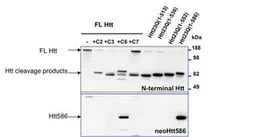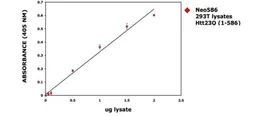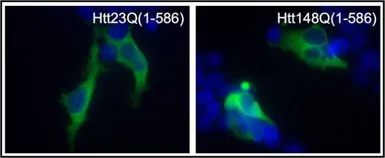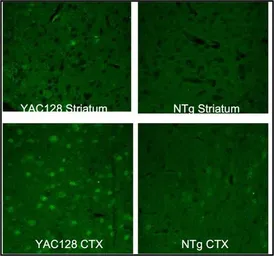APPLICATION
Application Note
*Optimal dilutions/concentrations should be determined by the researcher.
| Application |
Recommended Dilution |
| 1:500 |
| 1:50-1:200 |
| 1:50 - 1:200 |
| 1:20 - 1:100 |
Not tested in other applications.
Calculated MW
Product Note
This antibody recognizes the 586 cleaved fragment without detecting the full-length form.
PROPERTIES
Form
Liquid
Buffer
PBS, 0.1% BSA
Preservative
0.05% Sodium azide
Storage
Store as concentrated solution. Centrifuge briefly prior to opening vial. For short-term storage (1-2 weeks), store at 4ºC. For long-term storage, aliquot and store at -20ºC or below. Avoid multiple freeze-thaw cycles.
Concentration
0.6 mg/ml (Please refer to the vial label for the specific concentration.)
Antigen Species
Human
Immunogen
Synthetic peptide conjugated to KLH via cysteine corresponding to CPSDSSEIVLD (577-586) of Human HTT.
Purification
Purified by affinity chromatography
Conjugation
Unconjugated
Note
For laboratory research use only. Not for any clinical, therapeutic, or diagnostic use in humans or animals. Not for animal or human consumption.
Purchasers shall not, and agree not to enable third parties to, analyze, copy, reverse engineer or otherwise attempt to determine the structure or sequence of the product.
TARGET
Synonyms
huntingtin , HD , IT15 , LOMARS
Cellular Localization
Cytoplasm,Nucleus
Background
Huntingtin is a disease gene linked to Huntington's disease, a neurodegenerative disorder characterized by loss of striatal neurons. This is thought to be caused by an expanded, unstable trinucleotide repeat in the huntingtin gene, which translates as a polyglutamine repeat in the protein product. A fairly broad range of trinucleotide repeats (9-35) has been identified in normal controls, and repeat numbers in excess of 40 have been described as pathological. The huntingtin locus is large, spanning 180 kb and consisting of 67 exons. The huntingtin gene is widely expressed and is required for normal development. It is expressed as 2 alternatively polyadenylated forms displaying different relative abundance in various fetal and adult tissues. The larger transcript is approximately 13.7 kb and is expressed predominantly in adult and fetal brain whereas the smaller transcript of approximately 10.3 kb is more widely expressed. The genetic defect leading to Huntington's disease may not necessarily eliminate transcription, but may confer a new property on the mRNA or alter the function of the protein. One candidate is the huntingtin-associated protein-1, highly expressed in brain, which has increased affinity for huntingtin protein with expanded polyglutamine repeats. This gene contains an upstream open reading frame in the 5' UTR that inhibits expression of the huntingtin gene product through translational repression. [provided by RefSeq, Jul 2016]
Database
Research Area
DATA IMAGES

|
GTX54522 WB Image
WB analysis of endogenous HTT lysates with or without different caspase activity (Lanes 1-5) and overexpressed recombinant HTT fragment lysates (Lanes 6-9) using GTX54522 Huntingtin (neoepitope 586) antibody (Bottom panel) and pan-HTT antibody (Top panel).
Dilution : 1:500
Loading :20 μg
|

|
GTX54522 ELISA Image
Sandwich ELISA was performed with a Huntingtin monoclonal antibody and GTX54522 Huntingtin (neoepitope 586) antibody to determine the antigen concentration of the Huntingtin cleavage products. The curve represents a dose response for neo586 in 293T cells overexpressing the Htt construct.
|

|
GTX54522 ICC/IF Image
ICC/IF analysis of 293T cells transfected with Htt23Q and Htt148Q stop constructs ending in amino acid 586 using GTX54522 Huntingtin (neoepitope 586) antibody.
Fixation : Formalin
Permeabilization : 0.1% Triton X-100 in TBS for 10 minutes
Dilution : 1:50 for at least 1 hour at room temperature
|

|
GTX54522 IHC-Fr Image
IHC-Fr analysis of mouse striatum (top panels) and cortex (bottom panels) tissue from either transgenic HD mice of the YAC128 line (left panels) or their WT littermates (right panels) using GTX54522 Huntingtin (neoepitope 586) antibody.
Green : Primary antibody
Dilution : 1:50
|
REFERENCE
There are currently no references for Huntingtin (neoepitope 586) antibody (GTX54522). Be the first to share your publications with this product.
REVIEW
There are currently no reviews for Huntingtin (neoepitope 586) antibody (GTX54522). Be the first to share your experience with this product.







